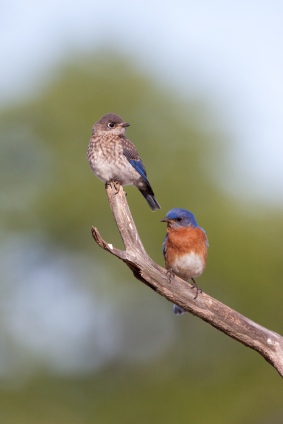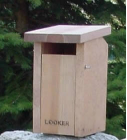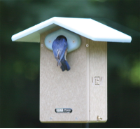-
bluebird houses alone may not cut it
The “Bluebird of Happiness” is one special little songbird that many backyard birders try to entice to their yards. The task can sometimes prove fruitless without the right combination of elements.
First there’s shelter, in the form of nest boxes, or bluebird houses. But don’t expect success with just slapping up a house. Proportionally-sized for Eastern and Western Bluebirds, these houses have certain features required for a successful brood. A predator guard is a plus, and having a duplicate bluebird house nearby may help with the fierce competition by non-native birds like the House Sparrow. Placement is important too, as Bluebirds prefer their nest boxes in open spaces. Shelter also involves cover, protection from predators in the form of mature trees and shrubs.
Now bluebird houses can run the gamut from your basic nest box (which serv
es the purpose well) to detailed copper roof houses, and decorative artisan’s works. The main thing is proportion and size, and drainage. Some bluebird houses will have a raised screen on the floor to prevent parasites, others have built in predator guards, and some have clear acrylic viewing windows to check the progress of nestlings without disturbing them. Some may have all these features, while others may have none of them. You usually get what you pay for in this instance, but again, a basic nest box will
likely do the trick.
Next is the feeder…Bluebirds are not seed eaters, and are not very likely to frequent this type of bird feeder. Traditional bluebird feeders are a “fly-in” style. They have have holes for the birds to enter and leave. Not many other species will use this kind of feeder…don’t ask me why bluebirds do! On occasion, I’ve seen Black Capped Chickadees enter our feeder in search of the coveted live mealworms. Tray feeders will also entice bluebirds if their favorite foods are offered. Number one choice…live meal worms. Once discovered, they’ll usually stick around for a daily offering of the juicy treat.
The last recommendation would have to be a birdbath. Fresh water offered on a consistent basis has got to be the single, most effective way to attract any wild birds. Especially in winter, a heated bath is a popular hangout where you’ll see many grateful little songbirds! Last winter, our Eastern Bluebirds over-wintered, and toughed out one of the most miserable winter seasons i can remember. Largely because of the heated bird baths, and live meal worms which were fed twice daily. Two successful broods last spring were truly a joy to watch fledge and grow. Once success is achieved…you’ll be hooked on Bluebirds…Happy Birding!
- Bird Accessories, Bird Houses, Blue Bird Houses, Bluebird Houses, Decorative Bird Houses, Recycled Birdhouses, Uncategorized, Unique Birdhouses, Wood Birdhouse
Blue Bird Houses: Basic Nest Box to Castle!
Nest Box basics to recycled houses, to deluxe architectural models, Blue Bird Houses come in many shapes and sizes!
Provide bluebirds with their required nest sites and help this iconic species continue to thrive. Competition for these nesting cavities is still fierce, and by putting up blue bird houses, you can encourage them to nest in your yard.
The best houses are not the most expensive, but the ones which are approved by The North American Bluebird Society. They have proper dimensions and drainage, and usually have some type of predator guard around the entrance. Simple nest boxes, can be acquired for as little as $15 to $20. While the more fancy and decorative models range anywhere from $50 to $400 depending on materials used and level of detail. This patina copper top bluebird house is actually hand crafted of PVC, the same vinyl siding on your house! These types of houses will never crack, split or fade, and generally last a lifetime.
Nesting material and bird baths will also encourage bluebirds to take up residence, as well as their favorite food: meal worms!






